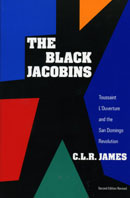
The Black Jacobins
Toussaint L'Ouverture and the San Domingo Revolution
James, C.L.R.
Publisher: Vintage, New York, USA
Year First Published: 1938
Year Published: 1963
Pages: 428pp Price: $22.95 ISBN: 0-679-72467-2
Resource Type: Book
Cx Number: CX6733
An account of the Haitian Revolution of 1791-1803.
Abstract:
The Black Jacobins is a historical account of the Haitian Revolution of 1791-1803. This revolution, inspired in part by the storming of the Bastille in Paris, led to the independence of Haiti. The people of San Domingo were able to overcome French rule and slavery. The story begins with a slave, Toussaint L'Ouverture, who organized the slaves in this colony and whose actions led to the establishment of a republic governed by people of African descent. It was a twelve-year struggle that became a model for third-world liberation movements. The only successful revolt in Haiti, it ended with the defeat of Napoleon Bonaparte's forces. This book seeks to reveal how this revolt made such an impact.
The history of the Haitian Revolution starts at the very beginning of the slave trade, and so this book begins with Christopher Columbus's arrival in the New World. After killing off the majority of the natives in a single generation, the Spanish decided to bring boatloads of Africans to San Domingo. The social impact of slaves as property is explored, as well as the historical laws regarding slavery. The influence of the French Revolution on the third world is also analyzed. The story of Toussaint's coalition and personal rise to power is told as well as that of the abolition of slavery in Haiti. Toussaint was defeated and captured in the War of Independence, but in the end Haitian rebels were able to complete his work. This book is a chronological account of the struggle and an in-depth look at the political and social implications.
The Appendix, "From Toussaint L'Ouverture to Fidel Castro", ties the Haitian Revolution to that of Cuba in that the Cuban Revolution completed the quest for a national identity in the Caribbean. "West Indians first became aware of themselves as a people in the Haitian Revolution". Through independence, the Caribbean has gained strength and unity.
[Abstract by Mia Manns]
Table of Contents
Preface to the Vintage Edition
Preface to the First Edition
Prologue
1. The Property
2. The Owners
3. Parliament and Property
4. The San Domingo Masses Begin
5. And the Paris Masses Complete
6. The Rise of Toussaint
7. The Mulattoes Try and Fail
8. The White Slave-Owners Again
9. The Expulsion of the British
10. Toussaint Seizes the Power
11. The Black Consul
12. The Bourgeoisie Prepare to Restore Slavery
13. The War of Independence
Bibliography
Appendix: From Toussaint L'Ouverture to Fidel Castro
Index
Subject Headings


